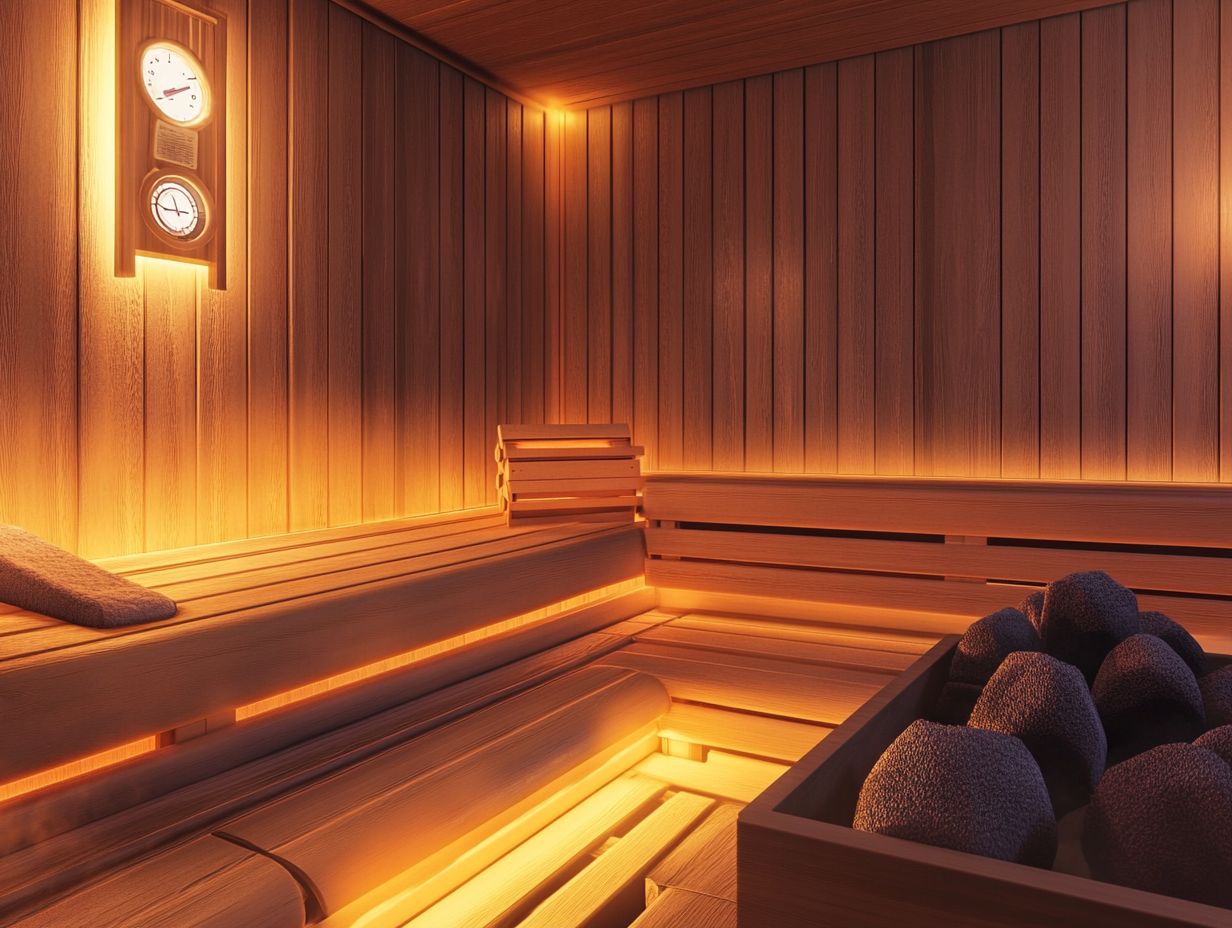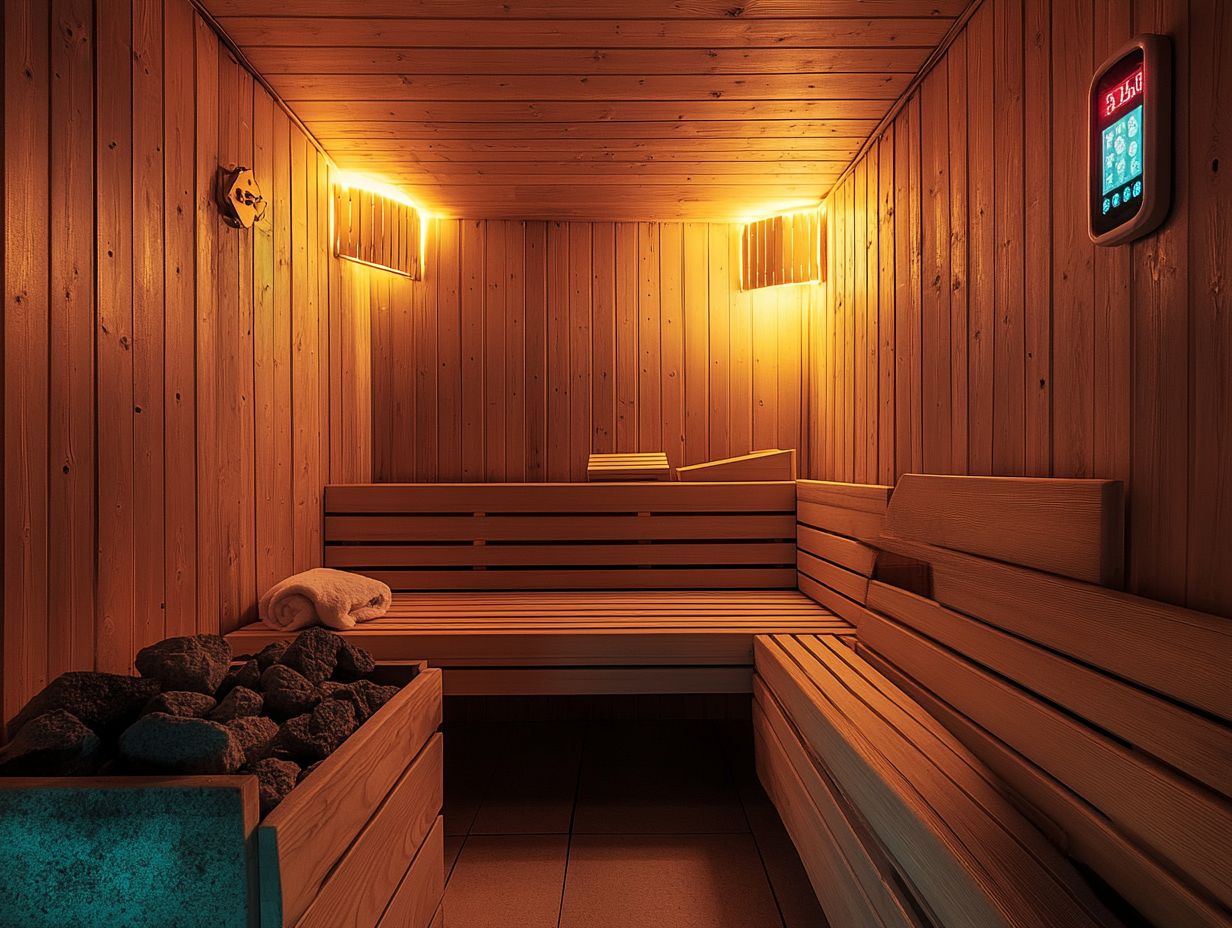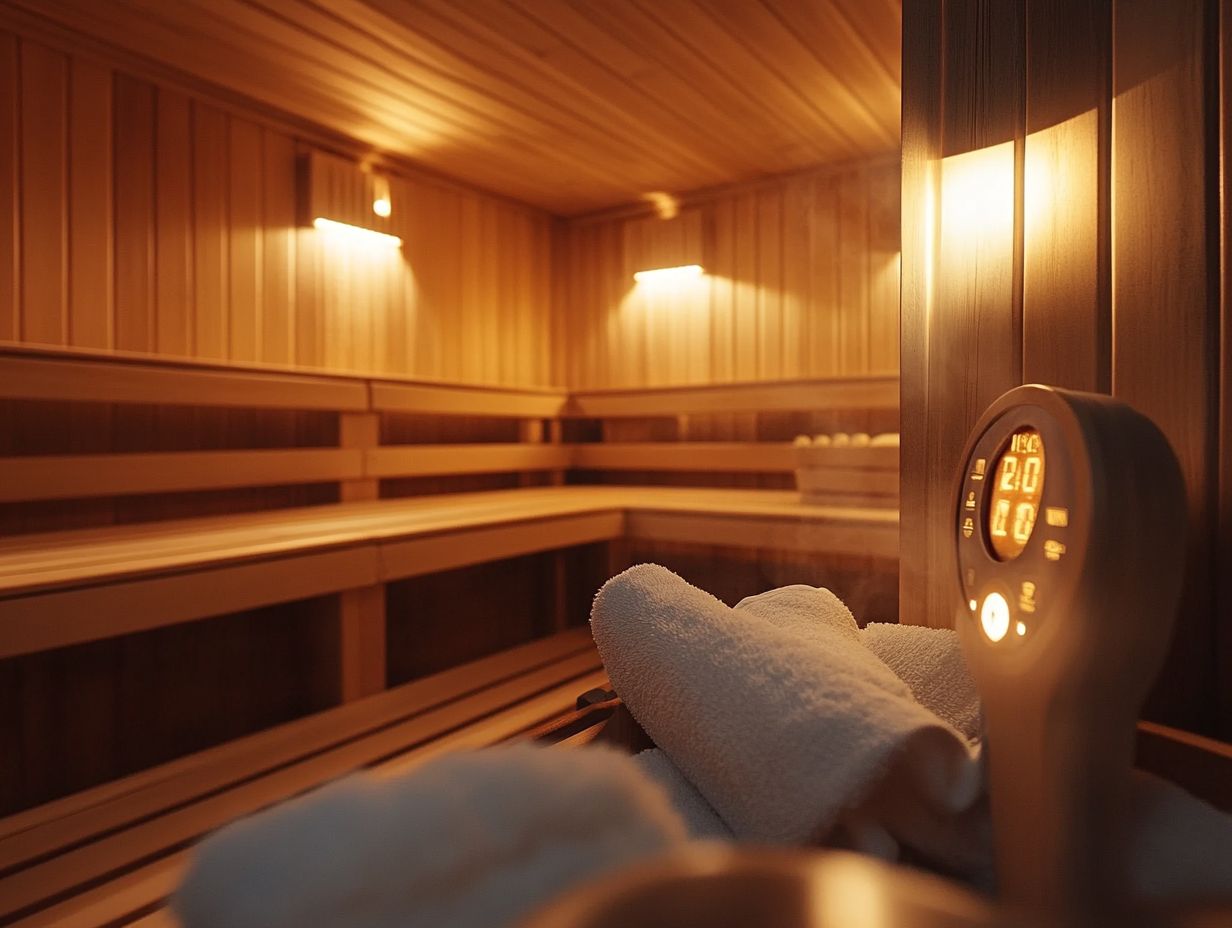How to Maximize Safety in Your Sauna Experience
Saunas present a unique combination of relaxation and health benefits, but it’s essential to approach them with an informed mindset.
This guide will navigate you through the subtleties of the sauna experience. It offers insights into how they function and outlines the essential safety precautions to consider before stepping inside.
You’ll also discover what actions to take during and after your session to enhance the benefits while reducing potential risks. Whether you re a seasoned sauna enthusiast or a curious newcomer, this article equips you with the knowledge needed for a safe and enjoyable experience.
Contents
Key Takeaways:

- Understand the basics: Know what a sauna is and how it works to make informed decisions before entering, including the benefits of regular use.
- Prioritize safety: Evaluate your health and prepare accordingly. Shower before entering, stay hydrated, and monitor body temperature during the session.
- Take precautions: After your sauna session, cool down and rehydrate properly. Be aware of potential risks and know when to seek medical help, especially if you have pain conditions.
Understanding the Sauna Experience
The sauna experience transcends mere indulgence; it s a holistic wellness ritual cherished by sauna enthusiasts worldwide. It offers remarkable health benefits, from improved circulation to enhanced mental tranquility.
Whether you choose the soothing warmth of an infrared sauna or the classic embrace of a traditional sauna, you ll find yourself in a serene environment that fosters relaxation and rejuvenation.
Here, immerse yourself in mindfulness meditation, breathing exercises, and enhance benefits with essential oils to elevate the experience to new heights of well-being.
What is a Sauna and How Does it Work?
A sauna is a small sanctuary designed for high temperatures that encourage sweating and relaxation. There are two primary types: traditional saunas, which use heated stones for the classic l yly experience, and infrared saunas, which directly warm your body with infrared heat, providing maximum health benefits.
In traditional saunas, temperatures typically range between 150 F and 195 F (65 C to 90 C). The humidity levels create a unique atmosphere where you can pour water over the hot stones, producing a delightful burst of steam. On the other hand, infrared saunas operate at lower temperatures, usually between 120 F and 140 F (49 C to 60 C). Despite this, they penetrate deeper into your skin, promoting enhanced detoxification as you sweat.
Sweating in either type not only helps release toxins but also improves blood circulation, delivering additional cardiovascular benefits. Whether you prefer the dry heat of a traditional sauna or the soothing embrace of an infrared option, both offer effective pathways to relaxation and overall wellness.
Safety Precautions Before Entering a Sauna
Before stepping into a sauna, it’s essential to grasp the safety precautions necessary to fully enjoy the health benefits while minimizing risks related to heat exposure. This is crucial for those with pre-existing conditions or those new to the sauna experience.
Being informed allows you to relax and reap the rewards without unnecessary concerns.
Assessing Personal Health and Risks
Assessing your personal health is crucial, especially if you re dealing with pain conditions like fibromyalgia or arthritis. These conditions can influence your body’s response to the high temperatures typical of a sauna.
To ensure a safe experience, it s vital to evaluate your cardiovascular health. If you have existing heart conditions, you may face increased risks of overheating or sudden fluctuations in blood pressure. If you suffer from chronic respiratory issues, consider how inhaling hot, humid air might affect your breathing.
If you’re on medications that impact blood circulation or hydration levels, it’s wise to talk to your healthcare provider about sauna use. This consultation can offer tailored advice, allowing you to enjoy the sauna while minimizing health risks. Additionally, consider checking out how to maximize your sauna experience for more tips on safe usage.
Preparing for the Sauna Session

Preparing for your sauna session is an art. It involves thoughtful steps to ensure you’re hydrated, your skin is primed, and your experience is elevated.
Start with gentle exfoliation to boost circulation. Consider adding essential oils for relaxation.
Before entering the sauna, hydrate thoroughly. Your body loses fluids through sweat. Sip on water or herbal tea to replenish lost electrolytes.
After exfoliating, apply a light moisturizer. This protects your skin from excessive dryness and enhances the sauna’s benefits.
Using essential oils like eucalyptus or lavender can make your sauna time enjoyable. These scents fill the air and create a relaxing atmosphere.
With the right preparation, savor the myriad benefits of this rejuvenating wellness practice.
During the Sauna Session
During a sauna session, monitor your body temperature. Maintain proper hydration by drinking water or a sports drink to replace lost fluids.
Follow expert sauna tips to amplify the benefits of your sauna experience. This can turn your time into a refreshing ritual.
Proper Hydration and Monitoring Body Temperature
Proper hydration is vital during a sauna session. Sweating leads to significant fluid loss, so stay hydrated and know when to cool down.
Staying hydrated helps your body manage its temperature. This also replaces the minerals lost when you sweat.
Drink water or opt for electrolyte-rich beverages like coconut water before stepping into the sauna.
Throughout the session, hydration helps counterbalance the effects of intense sweating. Water is the most reliable choice due to its accessibility.
After the sauna, continue to hydrate for recovery and to prevent feelings of fatigue.
Be aware of signs of overheating, like dizziness or excessive fatigue. This ensures your safety and enjoyment of heat therapy.
Managing Time and Temperature
Time management and temperature adjustment are essential for maximizing your sauna session benefits. A structured routine enhances relaxation and aids recovery.
If you’re new to sauna use, start slow. Limit sessions to 10 to 15 minutes to gauge your comfort.
For seasoned users, extend your time to around 20 to 30 minutes based on your preference and tolerance. Always listen to your body; if you feel dizzy or overly hot, step out to cool down.
Adjust the sauna’s temperature, typically between 150 F and 195 F, to fit your comfort. Remember, hydration is key before and after your session to replenish lost fluids.
Incorporating deep breaths and mindfulness practices can elevate your relaxation. This transforms the sauna into a holistic journey for your well-being.
After the Sauna Session
After your sauna session, prioritize the cool down and rehydration processes. These steps are essential for detoxification and restoring your body’s balance.
Fully embrace the myriad benefits of your sauna experience.
Cooling Down and Rehydrating

Cooling down after a sauna session is vital. It helps your body return to its normal temperature and rehydrate with water or sports drinks.
Mixing effective cooling methods can supercharge your recovery. A cool shower can work wonders, helping to lower your body temperature and refresh your skin. Gentle stretching promotes relaxation and boosts circulation, aiding in the cooling process.
Consider sipping on drinks that help replace lost minerals. These beverages not only rehydrate but also restore essential minerals lost during sweating.
This combination of cooling methods and optimal hydration rejuvenates your body and prepares you for your next activity, ensuring you feel at your absolute best.
Tips for Sauna Recovery
To elevate your sauna recovery experience, integrate stretching techniques and mindfulness meditation. These practices encourage relaxation and enhance the benefits of your sauna time, especially when complemented with essential oils.
After a rejuvenating sauna session, engage in gentle stretching exercises that target major muscle groups. These stretches ease tension and boost flexibility, leaving your muscles revitalized.
Pairing this with mindfulness meditation allows you to deepen your relaxation, centering your thoughts and promoting calming breaths. Consider using essential oils like lavender or eucalyptus during recovery. A few drops in a diffuser or blended with a carrier oil for a soothing massage can elevate your experience and create a sense of tranquility.
Potential Risks and How to Address Them
Understanding the potential risks of sauna use is crucial for ensuring a safe and rewarding experience. Familiarize yourself with necessary safety measures and recognize when to seek medical attention.
Common Risks and Safety Measures
Common risks like overheating and dehydration make it essential to implement safety measures and adhere to proper sauna etiquette for an enjoyable experience.
To mitigate these risks, prioritize staying well-hydrated before and after your sauna session. Take breaks every 15-20 minutes to cool down, and monitor your heart rate to gauge your limits. A thermometer can help identify comfortable temperatures for relaxation.
Practicing sauna etiquette is equally important. Maintaining a quiet atmosphere, cleaning up after yourself, and avoiding excessive noise fosters a respectful environment that enhances everyone s enjoyment and safety.
When to Seek Medical Attention
Knowing when to seek medical attention is vital for sauna users, especially if you notice concerning signs that could indicate serious health issues during or after a session.
Pay close attention to how your body reacts to the heat; certain symptoms may signal an urgent need for medical evaluation. For instance, persistent headaches or dizziness after a session are red flags that require your attention.
If you have pre-existing health conditions, such as cardiovascular or respiratory issues, be aware that sauna use can exacerbate these and lead to complications. Recognize your limits and consult a healthcare professional to understand how your health profile interacts with sauna experiences.
Frequently Asked Questions

What are the benefits of using a sauna?
Using a sauna can improve circulation, reduce stress, and relax muscles. It can also aid in detoxification and weight loss.
How can I maximize safety in my sauna experience?
Always follow the manufacturer’s instructions.
Limit your sauna time to 15-20 minutes and stay hydrated by drinking water!
Are there any potential risks associated with using a sauna?
Yes! Risks include dehydration, burns from hot surfaces, and dizziness.
Pay attention to your body and use caution.
Can anyone use a sauna?
Check with your doctor if you have health concerns.
Those with heart conditions, high blood pressure, or pregnant women should be extra cautious.
How often should I use a sauna?
Use a sauna 2-3 times a week.
Listen to your body and take breaks as needed.
What should I wear in the sauna?
You can wear a towel, a bathing suit, or go nude.
Avoid metal jewelry that can heat up!






